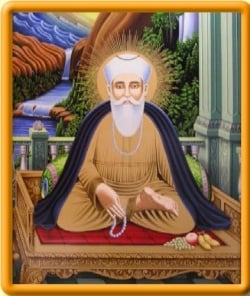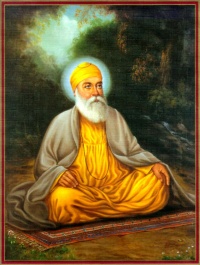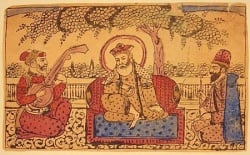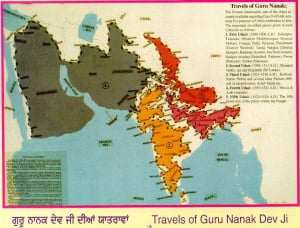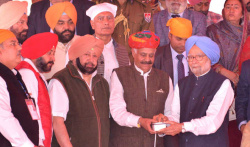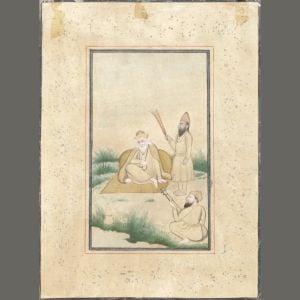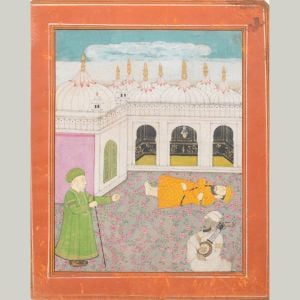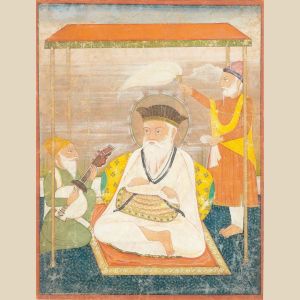Guru Nanak
- "The Bounteous Lord heard the anguished cries (of humanity),
- and so, Guru Nanak, He sent to this world of woe." - Bhai Gurdas Ji
| Guru Nanak Dev ji (1469 to 1539) | |
| Full Name : | Nanak Dev |
| Personal Details | |
| Birth : | On Saturday 15 April, 1469 at Rai Bhoeki Talwandi, Pakistan (Nankana Sahib) |
| Guruship : | 1469 to 1539 |
| Joti Jot : | On Monday 22 September, 1539 at Kartarpur |
| Family | |
| Parents : | Mehta Kalu and Mata Tripta Devi |
| Brother/Sisters : | Sister Bebe Nanki |
| Spouse : | Mata Sulakhani |
| Children : | Sri chand and Lakhmi Das |
| Other Details | |
| Bani in GGS: | 974 Shabads in 19 Ragas, Gurbani Includes Japji, Sidh Gohst, Sohilaa, Dakhni Onkar, Asa di Var, Patti, Bara Mah |
| Other Info: | Four Udasis |
Guru Nanak Dev Ji (Gurmukhi: ਗੁਰੂ ਨਾਨਕ), the founder and first Guru of Sikhism, was born in the year 1469, in the village Talwandi which is located in the Punjab region of the Indian subcontinent. The village, now known as Nankana Sahib, is situated near the city of Lahore in present day Pakistan. Sikhs around the world celebrate the auspicious occasion of Guru Nanak Dev Ji’s birth on the Pooranmashi (full moon) day in the Lunar month of Katak (October-November), which falls on a different date every year.
Guru Nanak Dev ji's father, Mehta Kalu ji, was a village accountant. His mother, Mata Tripta ji, was described as a simple and very religious woman. He also had an elder sister named Bebe Nanki ji, who cherished her younger brother. From an early age, it was evident that Guru Nanak ji was an extraordinary child, distinguished by his divine grace. Blessed with a deeply contemplative mind and rational thinking, young Nanak ji would often astound his elders and teachers with the sublimity of his knowledge, particularly on divine matters. Growing up, he refused to partake in traditional religious rituals, and often spoke out against several prevalent societal practices such as the Caste System, idolatry, and the worship of demi-Gods. By the age of 16, Guru Nanak Dev ji had mastered multiple religious texts and languages including Sanskrit, Persian, and Hindi, and was writing what many believed were divinely inspired compositions.
In the year 1487, Guru Nanak Dev ji was married to Mata Sulakhni ji, and they had two sons, Sri Chand and Lakhmi Das. The family, accompanied by Bhai Mardana, a Muslim childhood friend of Guru Nanak Dev ji, then moved to the town of Sultanpur Lodhi, where Guru ji took the job of an accountant in charge of the stores of the local Governor. Here, Guru Nanak ji worked during the days, but during the early mornings and late nights, he meditated and sang hymns accompanied by Bhai Mardana on the rabab (a stringed instrument). During one of those early mornings while bathing in “Vain Nadi” (a small river), Guru Nanak ji heard God‘s call to dedicate himself completely to the service of humanity. The very first sentence which he uttered then was, "There is no Hindu, no Musalman (Muslim)". Stating that he had been taken to the God's court and given a divine mission, Guru Nanak ji then began the next stage of his life, to preach his unique doctrine (Sikhi) to the entire world.
For the next 30 years, accompanied by Bhai Mardana, Guru Nanak Dev ji undertook four major spiritual journeys, running across India, South Asia, Tibet and Arabia, covering about 30,000 kilometers. In these journeys, he preached the new concept of God as "Supreme, All powerful and Truthful, Formless (Nirankar), Fearless (Nirbhau), Without hate (Nirvair), the Sole (Ik), the Self-Existent (Saibhang), the Incomprehensible and Everlasting creator of all things (Karta Purakh), and the Eternal and Absolute Truth (Satnam)". Guru ji taught people that the 'One' God dwells in every one of his creations, and that all human beings can have direct access to God without the need of any rituals or priests. Setting up a unique spiritual, social and political platform based on equality and fraternal love, Guru Nanak Dev ji attacked the citadel of the Hindu Caste System, and condemned the theocracy of Mughal rulers. He described the dangers of egotism, falsehood, and hypocrisy, and called upon the people to engage in worship through the "Naam" (the name of God). He rejected the path of renunciation (Tyaga), emphasizing a householder's (family) life based on honest conduct, selfless service (Sewa), and constant devotion and remembrance of God's name. Guru Nanak Dev ji promoted the equality of all mankind and upheld the causes of the downtrodden and the poor, laying special emphasis to assert the equality of women.
In the later years of his life, Guru ji founded and settled down at the township of Kartarpur ("creator's town"), on the banks of river Ravi in Punjab. Here, he donned the robes of a peasant, earning his own honest living by cultivating the lands. Followers came from near and far to listen to the Master. He introduced the institution of Langar (free communal kitchen) at Kartarpur, establishing the basic equality of all people regardless of their social and economic status. In the year 1539, knowing that the end was drawing near, Guru Ji, after having tested his own two sons and some followers over the years, installed Bhai Lehna ji (Guru Angad Dev Ji) as the Second Nanak, and after a few days passed into Sachkhand.
Guru Nanak Dev ji's writings, in the form of 974 spiritual hymns comprising the Japji Sahib, Asa di Var, Bara Mah, Sidh Gosht and Dakhni Onkar were incorporated in the scripture Guru Granth Sahib by the fifth Guru Arjan Dev ji. All the Sikh Gurus after Guru Nanak Dev ji continued to identify themselves as Nanak while penning down their sacred writings. Thus, Sikhs believe that all the Gurus possessed the same divine light and further strengthened the same doctrine as was propagated by Guru Nanak Dev Ji.
Among people of various faiths and traditions, Guru Nanak Dev Ji is variously revered as Satguru Nanak, Jagat Guru Nanak, Baba Nanak, Nanak Shah Faqir, Bhagat Nanak, Nanak Kalandar.
Bhai Gurdas ji's summary
ਸੁਣੀ ਪੁਕਾਰਿ ਦਾਤਾਰ ਪ੍ਰਭੁ ਗੁਰੂ ਨਾਨਕ ਜਗ ਮਾਹਿ ਪਠਾਇਆ || ਚਰਨ ਧੋਇ ਰਹਰਾਸਿ ਕਰਿ ਚਰਣਾਮ੍ਰਿਤੁ ਸਿੱਖਾਂ ਪੀਲਾਇਆ ||
ਪਾਰਬ੍ਰਹਮ ਪੂਰਨ ਬ੍ਰਹਮ ਕਲਿਜੁਗ ਅੰਦਰ ਇਕ ਦਿਖਾਇਆ || ਚਾਰੇ ਪੈਰ ਧਰਮ ਦੇ ਚਾਰਿ ਵਰਨ ਇਕ ਵਰਨੁ ਕਰਾਇਆ ||
ਰਾਣਾ ਰੰਕ ਬਰਾਬਰੀ ਪੈਰੀ ਪਵਣਾ ਜਗਿ ਵਰਤਾਇਆ | ਉਲਟਾ ਖੇਲੁ ਪਿਰੰਮ ਦਾ ਪੈਰਾਂ ਉਪਰਿ ਸੀਸ ਨਿਵਾਇਆ ||
ਕਲਿਜੁਗ ਬਾਬੇ ਤਾਰਿਆ ਸਤਿਨਾਮੁ ਪੜ੍ਹਿ ਮੰਤ੍ਰ ਸੁਣਾਇਆ || ਕਲਿ ਤਾਰਣਿ ਗੁਰੁ ਨਾਨਕ ਆਇਆ ||੨੩|| ਵਾਰ ੧ ||
The Provider Lord listened to the cries (of humanity), Guru Nanak ji descended into this world.
Washing His feet and praising God, he got his Sikhs to drink the ambrosial nectar (of humility).
In this Dark Age, he showed all gods to be just one.
The four feet of Dharma, the four castes were converted into one.
Equality of the King and beggar, he spread the custom of being humble.
Reversed is the game of the beloved; the egotist high heads bowed to the feet.
Baba Nanak rescued this Dark Age; read ‘satnam’ and recited the mantra.
Guru Nanak ji came to redeem this Dark Age of Kaljug. Bhai Gurdas - Vaar 1 pauri 23
His path
It was a dark and moonless night; the clouds were heavy with rain as it was the monsoon season. Suddenly lightning flashed and thunder sounded as a few raindrops started to fall. The village was asleep. Only Nanak ji was awake and the echo of his song filled the air.
Guru Nanak ji’s mother was worried because it was pitch dark and day break was far away. The lamp in his room was burning. She could hear his melodious voice as he sang, restraining herself no longer she knocked at his door. “Go to sleep, my son, the sun is a long way ahead.” Nanak became silent. From the darkness sounded the call of the sparrow-hawk. “Piyu, piyu, piyu!” it called.
- “Listen, mother!” Nanak ji called out. “The sparrow-hawk is calling to his beloved; how can I be silent, because I am competing with it? I will call my beloved before he calls his – even for longer because his beloved is nearby, perhaps in the next tree! My beloved is so far away. I will have to sing for lives upon lives before my voice reaches Him.” Nanak ji resumed his song.
Guru Nanak ji’s path was, is and will ever remain decorated with endless rows of true flowers; he realised God by singing virtues of God and following a life of true deeds. Guru Nanak Dev ji did not practise normal Hindu austerities, meditation or yoga; he only sang in the beautiful poetic forms of the time. Singing, often extemporaneously, with all his heart and soul, so much so that his singing became his meditation, his purification and his yugam (yoking ones self to the almighty, to Satguru. This was Guru Nanak ji’s path; decorated with true flowers of song, songs of glory and praise of the Almighty Lord.
Whatever he has said was said in verse straight from GOD. His blissful and mesmerizing songs are not those of an ordinary singer; they have sprung from within one who has known. There is the ring of truth, the reflection of God within them. It is these songs, songs of love and expressions of truthfulness and worship, along with the songs of Guru Nanak Dev ji's nine successors, that form the eternal Guru of the Sikhs, the Guru Granth Sahib.
Background
According to some ancient Sikh records, Guru Sahib was born in the early morning of the third day of the light half of the month of Baisakh (April - May), which is believed to be Saturday 15 April 1469 ; while some other chronicles state the date of birth as October 20, 1469. The Sikhs now celebrate this auspicious event each year on the Pooranmashi (full moon day) in the lunar month of Katak (October-November), which falls on different dates every year.
His father was Kalayan Das Mehta, also known as Mehta Kalu, and his mother was Mata Tripta. They belonged to the Vedic Kshatriya caste. His father was the local patwari (accountant) for crop revenue in the village of Talwandi. Guru ji had an elder sister named Bebey Nanki, who was the first to recognize Guru Nanak ji as an enlightened Soul.
| Relatives of Shri Guru Nanak Dev guru nanak |
|
Grandparents: ✝ Mata Banarasi ✝ Baba Shiv Ram ✝ Grandparents (Maternal):✝ Mata Bhirai ✝ Baba Rama |
Guru Nanak Dev ji from an early age evidenced a questioning and inquiring mind. He soon mastered the Vedas and Sanskrit and was enrolled into a Madrassa to study Persian and Arabic languages. Picking up both languages quickly, he surprised his teacher by composing an acrostic on the Persian language.
When it was time for Guru Nanak Dev ji to be invested with the twice born thread the “sacred” thread, called the Janeu, he refused to take part in the ritual. When the priest continued to insist that the young Nanak ji done the string he went into a trance and sang:
- Let mercy be the cotton, contentment the thread,
- Continence the knot and truth the twist.
- Oh priest! if you have such a thread,
- Do give it to me.
- It will not wear out, nor get soiled, nor be burnt, nor lost.
- Says Nanak, blessed are those who go about wearing such a thread.
- (Rag Asa)
Guru Nanak Dev ji's Life at Sultanpur
Guru Nanak ji married Sulkhni of Batala, and they had two sons, Sri Chand and Lakhmi Das. Guru ji's brother-in-law, the husband of his sister Nanki, obtained a job for him in Sultanpur as the manager of the government's grainary. One morning, when he was twenty-eight, he went as usual down to the river to bathe and meditate. It was said that he was gone for three days. When he reappeared, filled with the spirit of God, it was apparent to all that he was a changed man. He would say nothing, he quit his job and distributed all that he had to the poor. Accompanied by his childhood friend, a Muslim named Mardana who had always played the Rebab while Nanak ji sang, they left town. When, after a few days, he spoke saying "There is no Hindu, no Musalman."[1] It was then that Guru Nanak Dev ji began his missionary work and travels.
As a householder, Guru ji continued to carry out the mission of his life – to lead people on the true path to God, to dispel superstition, to bring people out of ritualistic practises, to lead them directly to follow Gurbani without the need for priests and clergy, and to restrain and guard against the five thieves within – Pride, Anger, Greed, Attachment and Lust.
Teachings
Guru Nanak Dev ji founded and formalised the three pillars of Sikhism:
- Naam Japna Guru Ji led the Sikhs directly to practise Simran and Naam Japna – meditation on God through reciting, chanting, singing, and constant remembrance followed by deep study & comprehension of God’s Name and virtues. In real life to practice and tread on the path of Dharam (righteousness) - The inner thought of the Sikh, thus stays constantly immersed in the praises and appreciation of the Creator and the ONE ETERNAL GOD Waheguru.
- Kirat Karni He expected the Sikhs to live as honourable householders and practise Kirat Karni – To honestly earn by ones physical and mental effort while accepting both pains and pleasures as GOD's gifts and blessings. One is to stay truthful at all times and fear none but the Eternal Super Soul. Live a life founded on decency immersed in Dharam - life controlled by high spiritual, moral, and social values.
- Vand Chakna. The Sikhs were asked to share their wealth within the community by practising Vand Chakna – “Share and Consume together”. The community or Sadh Sangat is an important part of Sikhism. One must be part of a community that is living by the flawless objective values set out by the Sikh Gurus and every Sikh has to contribute in whatever way possible to the common community pool. This spirit of Sharing and Giving is an important message from Guru Nanak Dev Ji.
Contributions to humanity
During his his time on Earth Guru Nanak Dev ji was revered by both Hindus and Muslims and even today many, outside of the Sikh faith, revere him. It is related that as he lay dying, his followers some formerly Hindu and others formerly Muslims argued whether his body should be cremated as Hindu tradition dictated or buried as in Islamic tradition. It is said that when they removed the sheet which had covered the Guru they found only beautiful flowers. The Hindus burned theirs, the Muslims buried theirs.
Following are highlighted contribution of Guru Nanak Dev ji:
Equality of humans
When in the middle east, the west and the rest of asia slavery, varna/class and race discrimination was rife and respect between the different classes and caste was at a peak, Guru Nanak Dev ji preached against discrimination and prejudices due to race, caste, status, etc. He said: "See the brotherhood of all mankind as the highest order of Yogis; conquer your own mind, and conquer the world." (SGGS page 6); also "There is one awareness among all created beings." (page 24) and finally "One who recognizes the One Lord among all beings does not talk of ego. ||4||" (page 432). He urges all the peoples of the world to "conquer" their minds to these evil practises. All human beings had the light of the Lord and were the same -- only by subduing one's pride and ego could one see this light in all.
Equality of women
In about 1499 when the world offered low to no status or respect to women, Guru Nanak Dev ji sought to improve the respect of women by spreading this message: "From woman, man is born; within woman, man is conceived; to woman he is engaged and married. Woman becomes his friend; through woman, the future generations come. When his woman dies, he seeks another woman; to woman he is bound. So why call her bad? From her, kings are born. From woman, woman is born; without woman, there would be no one at all. O Nanak, only the True Lord is without a woman." (page 473). In so doing, he promoted women's rights and equality — a first for the 15th century!
Universal message for all people
It had been a custom at the time for religious leaders to address only their own congregation and for segregation of the different religions -- but Guru Nanak Dev ji broke with tradition and spoke to all of humanity. To the Muslim he said: "And when, O Nanak, he is merciful to all beings, only then shall he be called a Muslim. ||1||" (page 141); to the Hindu, he said "O Nanak, without the True Name, of what use is the frontal mark of the Hindus, or their sacred thread? ||1||" (page 467); and to all he preached: "To take what rightfully belongs to another is like a Muslim eating pork, or a Hindu eating beef." (page 141).
| Guru Nanak Dev's Compositions |
|
Japji Sahib അ Sidh Gohst അ Dakhani Oankaru അ Kirtan Sohila അ Barah Maha |
Spiritual journeys
- Main article: The Udasis of Guru Nanak
Guru Nanak Dev ji made four great Spiritual journeys, traveling to all parts of India, Sri Lanka, Arabia and Persia. He visited head centers of all religions and had discourses with head priests of various sects of Hindus, Jains, Buddhists, Parsees, and Muslims. Everywhere he outcome in Spiritual discussions; therefore having followers from all religious backgrounds.
He spoke in the temples and mosques, and at various pilgrimage sites. Wherever he went, Guru Nanak Dev ji spoke out against empty religious rituals, pilgrimages, the caste system, the sacrifice of widows, of depending on books to learn the true religion, and of all the other tenets that were to define his teachings. Never did he ask his listeners to follow him. He asked the Muslims to be true Muslims and the Hindus to be true Hindus.
After the last of his great journeys, Guru Nanak Dev ji tried a new experiment - he asked a wealthy follower to donate a large tract of land . Here he built a town calling it Kartapur (in Punjab) on the banks of the Ravi where he taught for another fifteen years. Followers from all over came to settle in Kartapur to listen, and sing, and be with him. During this time, although his followers still remained Hindu, Muslim, or of the religion to which they were born, they became known as the Guru ji's disciples, or sikhs. It was here his followers began to refer to him as teacher, or guru. The Guru ji told his followers that they were to be householders and could not live apart from the world -- there were to be no priests or hermits. Here is where the Guru ji instituted the common meal, requiring the rich and poor, Hindu and Muslim, high caste and low caste, to sit together while eating. All worked together, all owned the town. Here is where Lehna, later to be Guru Angad, came to be with Guru Nanak Dev ji.
A well known legend, when Guru Nanak Dev ji met Babur (1483-1530) the Emperor of India offered him a shared pipe of [Bhang], Guru Nanak ji replied that he had a bhang whose wonderful effects never wore off. Inquiring of Guru Nanak ji where he could find such wonderful bhang - Guru Nanak ji declined the emperor's offer, saying GOD the [SAT GURU] was his bhang.
| Travels of Guru Nanak |
|
First Udasi · Second Udasi · Third Udasi · Fourth Udasi · Fifth Udasi |
One Event Related to Guru Nanak Dev
Guru Nanak Dev Ji once found a king, he told him that there is such a saint in his city who eats only once in six months and does spiritual practice all the time in a closed cave. When Sankranti comes after six months, he comes out of his cave and we all welcome him with drummers and prepare many dishes for him and give them to him, after eating them he goes back to his cave. goes. All our works are completed by his darshan. Gurudev ji told that king that now tell everyone that that saint will come out on the fifth month of sankranti, when people came to see him on sankranti, in fact he did not want to come there, so if he was not there, all of them left disappointed. went. When the next sankranti the same saint came out and he could not find anyone who used to chant his name. No one was there to welcome him today, everything was calm, so it made him feel very bad that no one came to welcome him. He suffered a heart attack and started famine from there. Then that king told Guru ji that it was wonderful that our saint ji left his life. We didn't understand anything. On this Guru ji said that he did not eat food but he was hungry to hear his praise. When he came out of his sadhna, people used to praise him a lot and play drums and drums, when it did not happen now, he felt very bad. And he died.
The Guru leaves for his heavenly abode
After completing his odysseys, Guru Nanak Dev ji settled in Kartarpur (meaning: The City of the Creator). This city was established by Guru Nanak Dev ji himself in 1522. The guru ji by then had become widely renowned and respected by everyone for the love and guidance he'd bestowed on humanity. The Sikh, Hindu and Muslim devotees all claimed the guru as one of their own prophets. When it became apparent that Guru Nanak Dev ji's end was imminent, an argument ensued as to who would claim the guru's body for funeral rites. The Muslims wished to bury him according to their customs, while the Sikhs and Hindus wished to cremate his body according to their beliefs. To settle the matter, Guru Nanak Dev ji himself was consulted as to how his remains should be disposed of, and by whom. He explained the concept of joti jot, that only his mortal body would expire, but that light which illumined him was the divine and imperishable light, and would pass to his successor Guru Angad Dev.
The guru ji requested his devotees to bring flowers and instructed the Sikhs and Hindus to place flowers on his right side and the Muslims to place flowers to his left side. He told them that permission for funeral rites would be determined by whichever set of flowers remained fresh through out the night. On Asu sudi 10, 1596 Bikrmi [Monday September 22, 1539 AD] Guru Nanak Dev ji breathed his last breath at Kartarpur. The Sikh, Hindu and Muslim devotees returned the following morning. They carefully lifted and removed the sheet which had been placed over the guru ji's body. All were amazed and astonished to discover that no trace at all remained of Guru Nanak Dev Ji's mortal body. Only fresh flowers remained, for not a single bud had wilted of any blossom which had been left by either Sikhs, Hindus, or Muslims, the night before.
The Muslims then buried the flowers, while the Hindus and Sikhs cremated them. Therefore, both a samadhi (Hindu traditional monument of remembrance) and a grave (according to Muslim traditions) were created by each community. A gurudwara now stands there, near the banks of river Ravi, next to a small village named Kothay Pind (village) on the West bank of the Ravi River in Punjab, Pakistan.
This Gurudwara is also visible from the Indian side of the border, from a Gurdwara at the historical town of Dehra Baba Nanak in India. Both sites are considered to be some of the holiest places in Sikhism.
Preparations for the 550th Celebrations of the birth of Guru Nanak Dev ji begin
- Main article: 550th Celebrations of the birth of Guru Nanak
In November 2019, the whole world will be celebrating the 550th birth anniversary of Guru Nanak Dev ji. In Punjab, India, on Friday, 23 November 2018, the Punjab Chief Minister Captain Amarinder Singh launched a year-long preparations for the celebrations of the 550th birth anniversary of Guru Nanak Dev, the founder of Sikhism which will be taking place in November 2019. He called upon people to set aside their religious and political differences to join his government in making it a memorable event. Addressing a large gathering in Sultanpur Lodhi in Kapurthala district, where Guru Nanak Dev ji spent over 14 years of his early life, the Captain exhorted the people to reconnect with his teachings, principles and ideals.
The Captain thanked Indian Prime Minister Narendra Modi and the Union government for acceding to various requests of the state government with regard to the celebrations. He hailed the Centre’s decision to develop the Kartarpur Sahib Corridor from Punjab’s Gurdaspur district to the International Border to facilitate Indian pilgrims to visit Gurdwara Darbar Sahib in Kartarpur in Pakistan. He said a long-pending demand of Punjab was on the verge of fulfilment and on November 26, he would join the President to lay the foundation stone of the corridor.
He also thanked the Government of Pakistan for reciprocating on the issue and said his government would also contribute, as may be required, to ensure timely completion of the project. Addressing the gathering, former Prime Minister Manmohan Singh expressed gratitude to Amarinder Singh and his government for giving him the opportunity to be part of this special moment. He expressed hope that all would rise above petty considerations of communalism and hatred to celebrate the event in a befitting manner.
The former prime minister exhorted the people to participate in the year-long celebrations with full enthusiasm and gaiety, regardless of caste, colour, creed and religion. Governor Badnore said it was a matter of pride for him to be part of the auspicious occasion. He called for universal brotherhood as the key message of the commemorative events.
Former Indian cricketer Kapil Dev, who was also present, presented a book, ‘We the Sikhs around the world’, relating to 100 gurdwaras across the globe, to Manmohan Singh, Badnore and Capt Amarinder. Earlier, Manmohan Singh, along with his wife Gursharan Kaur, Badnore and Capt Amarinder paid obeisance at the historic Gurdwara Ber Sahib here. Former Punjab Chief Minister Parkash Singh Badal and Shiromani Akali Dal (SAD) President Sukhbir Singh Badal also paid obeisance at Gurdwara Ber Sahib.
Guru Nanak ji saakhis
- Main article: Sakhis of Guru Nanak
Article By @ramblingsofasikh Via-Instagram
"Sometime he [Guru Nanak Dev Ji] would engage in building an idol temple (dera) of the Hindus and at other times devote himself to laying the foundations of a mosque, in accordance with the law if Islam.
Sometimes he would circumambulate the House of God [Kaaba, Mecca] in accordance with the customs of the mystical and spiritual people; and sometimes, he would go to visit the tower of Jagannath and Kashi.
He travelled to all the four quarters of the world, and owing to his travels and journeys, his entire legs up to the knees were worn down. In every land there was an uproar over his words, and in every country there was tumult from his reality-surveying compositions."
Source— Guru Nanak, Guru Gobind Singh, and the Revolt Under Banda Bahadur, 1709-10 & 1713-16-From Muhammad Qasim "I brat", 'Ibratnama, translated by Irfan Habib
"The Guru believes in one God. His followers put not their faith in idol-worship. They never pray or practice austerities like the Hindus. They believe not in their incarnations, or places of pilgrimage nor the Sanskrit language which the Hindus deem to be the language of gods. They believe that all the Gurus are the same as Nanak. The Sikhs are not restricted in the matter of eating or drinking. When Partap Mall Giani saw a Hindu boy who had a mind to embrace Islam, he said, 'Why do you become a Muhammadan? If you have an inclination to eat everything, you may become a Sikh of the Guru and eat whatever you like."
Dabestān-e Mazaheb دبستان مذاهب or the "School of Religions" is a mid-17th century, Persian work that examines and compares South Asian religions and sects.
The work, whose authorship is uncertain, was probably composed in about 1655 CE and is most commonly attributed to Mohsin Fani. - Mohsin Fani, a noted Persian historian from Iran, was a friend of Guru Hargobind Sahib Ji up until Guru Hargobind Sahib Ji's passing in 1644.
In between 1645 and 1654 Mohsin Fani produces his great work. Mohsin writes that Guru Nanak Dev Ji was the figurehead of their movement.
The Nanak-Panthis are seen as a distinct group, based on their peculiar doctrines, their institutions and their social attitudes - including their sense of commitment to matters temporal as well as spiritual.
Chapter II of Dabestān-e Mazāheb includes a fascinating section and one of the earliest written records of Sikhs - labelled as "Nanak-Panthis". Bhai Kahn Singh Nabha references sections of the Dabistan-E-Mazahib to claim his point on Sikhs not following Hindu rituals and being a separate group altogether in Ham Hindu Nahin.
A Visit to the Tomb of Guru Nanak Dev Ji before 1647 "My mother took hold of my hand and started the journey we went to the village of Baba Nanak. The attendants of the Blessed Shrine gave the intelligence about him that, that beneficent one came by the one true path and never came by another."
"When we bowed our heads for pilgrimage to the shrine of Baba Nanak, we saw that there was a mari [funeral shrine], and by the side of the mari, was his mazar [tomb]. Who can come between the pure body and its frame [the body] of dust? For the life of those whose hearts have life, an arrow turns into a mere thorn!
They become bodies of air when they are reduced to dust [if they are buried on death] and acquire the form of water, if they are thrown into fire [i.e. cremated]."
Surat Singh, Tazkira Pir Hassu Teli. Translated by S. Ali Nadeem Rezavi. From Sikh History from Persian Sources, J.S. Grewal, Irfan Habib, Page 85.
The Tazkiratu'sh Shaikh wa'l-Khadam, also known as Tazkira Pir Hassu Teli, is a metrical work written in the Punjab region during the reign of Shahjahan (5 January 1592-22 January 1666).
The author, Surat Singh, was of the Kambo caste, the son of Duni Chand, and born at Natesar in pargana Patti Haibatpur in Punjab. Surat Singh's family were by profession traders but he took to the career of a revenue official, holding posts at Lahore, Bhatinda, and other places.
The Tazkira makes it apparent that Guru Nanak Dev Ji's religious status was widely accepted in 17th century Punjab and Guru Nanak was popular amongst Hindus and Muslims.
It becomes clear that at least till 1647 a shrine and a tomb of the Guru was extant on the banks of the River Ravi at Kartarpur.
Surat Singh's work is an important historical document for understanding how the message of Guru Nanak Dev Ji was looked at by the mystically inclined in Punjab. It is also one of the first statements in Persian regarding the Sikh message and illustrates how numerous traditions were trying to appropriate the image of Guru Nanak Dev Ji.
See also
- See Wikipedia article on Guru Nanak for more information
External links
- Eternal Glory of Sri Guru Nanak Dev Ji
- DiscoverSikhism
- Sikh Missionary Society
- Video on Guru Nanak Dev Ji
- Guru Nanak Dev
- Birth Date of Guru Nanak Sahib
- BBC on Guru Nanak
- Sikhs.org
- Complete information on Guru Nanak
- Guru Nanak Dev Ji Quotes
eBooks:
- Eternal Glory of Guru Nanak
- Max Arthur MacAuliff, The Sikh Religion, Vol 1, (The Life of Guru Nanak), Oxford University Press, 1909.
- Guru Nanak Dev Ji (for Children)
Audio:
Video:
References
- 2. Sikh Gurus, Their Lives & Teachings, K.S. Duggal, p 14
- 14. 'Guru Nanak Dev Ji and Chungthung' - Gyani Brahma Singh Brahma - The article 'Guru Nanak Dev Ji and Chungthung', written by Gyani Brahma Singh Brahma was published in Tract No 301 of Guru Nanak Dev Mission, Patiala, in November 1986. This article provides information about spots blessed by Guru Nanak's visit in Sikkim. The stories connected with these places are similar to the ones associated with Wali-Kandhari's event and Babe-di-ber at Sultanpur Lodhi.
- 24. Guru Nanak His Status and Salience - Sirdar Kapur Singh - The paper "Guru Nanak His Status and Salience" was read by Sirdar Kapur Singh on 30th November 1977, at the Khalsa College, Amritsar.
- 66. Sri Nanakana Sahib da Shaheedi Saka February 21, 1921 - Lal Singh, Narain Singh M.A. Tract No. 196
- 87. Guru Nanak Darshan
- 88. Guru Nanak - His Life and Teachings (3rd edition) - Dr. Ganda Singh
- 89. The Doctrine of Guru Nanak - Pritam Singh Gill
| Preceded by: Bhagats (1100 - 1469) |
Guru Nanak | Followed by: Guru Angad Dev (Second Sikh Guru) |
| These are the Ten Gurus of Sikhism |
|
Guru Nanak | Guru Angad Dev | Guru Amar Das | Guru Ram Das | Guru Arjan | Guru Hargobind | Guru Har Rai | Guru Har Krishan | Guru Teg Bahadur | Guru Gobind Singh |
| Relatives of Shri Guru Nanak Dev guru nanak |
|
Grandparents: ✝ Mata Banarasi ✝ Baba Shiv Ram ✝ Grandparents (Maternal):✝ Mata Bhirai ✝ Baba Rama |
| Events relating to Guru Nanak |
|
ӝ Guru's Birth ӝ At School ӝ In Baghdad ӝ The Sacred Thread ӝ reject the Janoy ӝ And Duni Chand ӝ In Tibet ӝ Tibet Quotes ӝ Udasis ӝ First Udasi ӝ Second Udasi ӝ Third Udasi ӝ Fourth Udasi ӝ Fifth Udasi ӝ In Nepal ӝ and Moola ӝ and Hot Spring ӝ and two students ӝ Sakhis ӝ In Mecca ӝ Grazing Buffaloes ӝ and Wali Qandhari ӝ Walli Kandhari ӝ in Istanbul ӝ mysteries ӝ Guru Nanak ӝ History ӝ Japji Sahib ӝ Philosophy ӝ reject the Janoy ӝ Guru's Birth ӝ no Hindu, no Musalman ӝ |
| Gurus: | Nanak Dev | Guru Angad | Amar Das | Ram Das | Guru Arjan | Har Gobind | Har Rai | Har Krishan | Tegh Bahadur | Gobind Singh | Guru Granth Sahib | Sikh Bhagats |
| Philosophy: | Sikh Beliefs | Simran | Sewa | Beliefs and Principles | Underlying Values | Prohibitions | Technique and Methods | Other observations | Technique and Methods |
| Practices: | Ardas | Amrit Sanskar | Chardi Kala | Dasvandh | Five Ks | Kirat Karni | Kirtan | Langar | Naam Japna | Simran | Three Pillars | Vand Chakna | Five Evils | Five Virtues |
| Scripture: | Guru Granth Sahib | Sikh Scripture | Dasam Granth | Ek Onkar | Waheguru | Bani | Mool Mantar | Japji Sahib | Jaap Sahib | Chaupai | Anand Sahib | Tav-Prasad Savaiye | Rehras | Sukhmani |
| More: | History | Gurdwaras | Harmandir Sahib | Khalsa | Khanda | Names | Places | News | Satguru | Sikhs | Bhagat Farid | Bhagat Kabir | Websites | Biographical | Terms |
